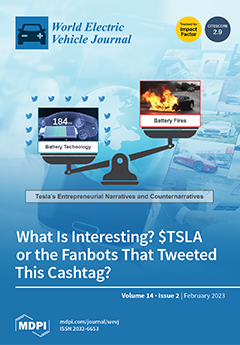World Electr. Veh. J., Volume 14, Issue 2 (February 2023) – 30 articles
A series of computational accounts (Fanbots) on Twitter may have played a role in sustaining the many entrepreneurial narratives of Tesla. From 2010 to 2020, these agents generated pro-firm tweets (Corporate Computational Propaganda, CCP), accounting for ~10% of the “$TSLA” cashtag activity. These accounts predate political computational propaganda associated with foreign support for Brexit in the UK and Donald Trump in the US (2016). Although the sources or stated purpose of these accounts are not directly observable, indirect indicators suggest that these accounts were intended to influence social perceptions of Tesla through a process of visibilization. Subject to contextual boundaries, the presence of CCP in Tesla suggests a Fanbot-based strategy may be used to manage social approval during industry (re)emergence. View this paper
- Issues are regarded as officially published after their release is announced to the table of contents alert mailing list.
- You may sign up for e-mail alerts to receive table of contents of newly released issues.
- PDF is the official format for papers published in both, html and pdf forms. To view the papers in pdf format, click on the "PDF Full-text" link, and use the free Adobe Reader to open them.





